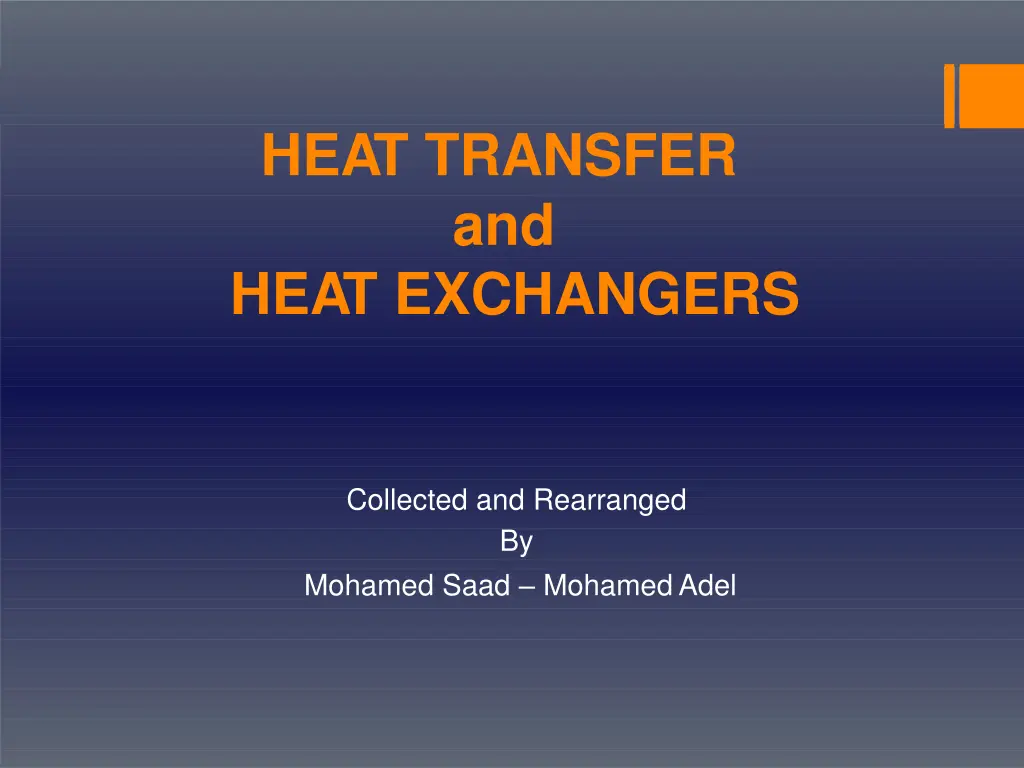
Heat Transfer and Heat Exchangers Essentials
Explore the fundamentals of heat transfer and heat exchangers, including conduction, convection, radiation, and thermal conductivity of various materials. Learn about key equations and concepts essential for understanding heat exchange processes.
Uploaded on | 0 Views
Download Presentation

Please find below an Image/Link to download the presentation.
The content on the website is provided AS IS for your information and personal use only. It may not be sold, licensed, or shared on other websites without obtaining consent from the author. If you encounter any issues during the download, it is possible that the publisher has removed the file from their server.
You are allowed to download the files provided on this website for personal or commercial use, subject to the condition that they are used lawfully. All files are the property of their respective owners.
The content on the website is provided AS IS for your information and personal use only. It may not be sold, licensed, or shared on other websites without obtaining consent from the author.
E N D
Presentation Transcript
HEAT TRANSFER and HEAT EXCHANGERS Collected and Rearranged By Mohamed Saad MohamedAdel
Heat Transfer by Conduction The transfer of energy between objects that are in physical contact Transfer of energy by touch
The Heat Conduction Equation Rate of heat generation inside control volume Rate of heat conduction out of control volume Rate of heat conduction into control volume Rate of energy storage inside control volume = + +
Heat Transfer by Convection The transfer of energy between an object and its environment, due to fluid motion
Natural Convection Convection heat transferred by the circulation of a fluid (or gas), such as in a heating system at home; important near the surface of the Sun. Hot air rises cool air falls
Heat Transfer by Radiation The transfer of energy to or from a body by means of the emission or absorption of electromagnetic radiation q = (Th4 - Tc4) Ac Th = hot body absolute temperature (K) Tc = cold surroundings absolute temperature (K) Ac = area of the object (m2) = 5.6703 10-8 (W/m2K4) The Stefan-Boltzmann Constant
Emissivity coefficient for several selected material Emissivity Coefficient SurfaceMaterial - - Aluminum Commercial sheet 0.09 Aluminum Foil 0.04 Aluminum Commercial Sheet 0.09 Brass Dull Plate 0.22 0.06 Brass Rolled PlateNatural Surface 0.02 Cadmium 0.81 Carbon,not oxidized Carbon filament 0.77 Concrete, rough 0.94 Granite 0.45 Iron polished 0.14 - 0.38 Porcelainglazed 0.93 Quartz glass 0.93 Water 0.95 - 0.963 0.25 Zink Tarnished
Heat Exchanger A heat exchanger is a piece of equipment built for efficient heat transfer from one medium to another The main concept is heat economy
1) Double pipe heat exchanger The simplest design for heat exchanger consist of two concentric pipes One fluid flow inside the small pipe and the second fluid flows in the space between the two pipes
2) Shell and tube heat exchanger Shell and tube heat exchangers consist of a series of tubes. One set of these tubes contains the fluid that must be cooled. The second fluid runs over the tubes that are being heated so that it can absorb the heat required
General design consideration Factor Tube-side Shell-side More corrosive fluid Less corrosive fluids Corrosion Fluids and scaling with high fouling Low fouling and scaling Fouling High temperature Low temperature Fluid temperature Fluids with low pressure drop Fluids with high pressure drop Operating pressure Less viscous fluid More viscous fluid Viscosity High flow rate Low flow rate Stream flow rate
3) plate and frame heat exchanger the plate heat exchanger is composed of multiple, thin, slightly separated plates that have very large surface areas and fluid flow passages for heat transfer. This stacked-plate arrangement can be more effective, in a given space, than the shell and tube heat exchanger.
Temperature profile for different types of heat exchangers






















